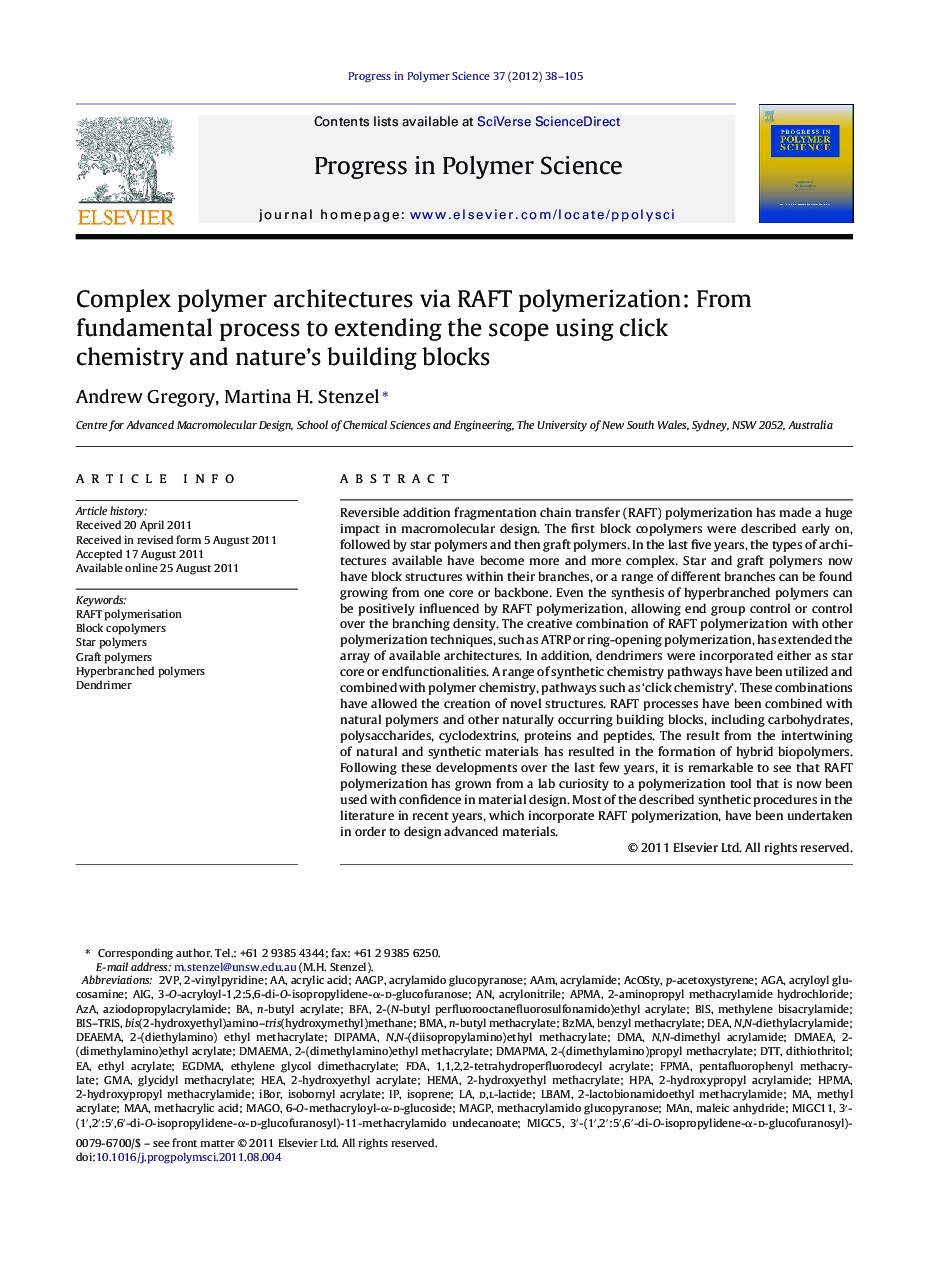| Article ID | Journal | Published Year | Pages | File Type |
|---|---|---|---|---|
| 5208314 | Progress in Polymer Science | 2012 | 68 Pages |
Abstract
Reversible addition fragmentation chain transfer (RAFT) polymerization has made a huge impact in macromolecular design. The first block copolymers were described early on, followed by star polymers and then graft polymers. In the last five years, the types of architectures available have become more and more complex. Star and graft polymers now have block structures within their branches, or a range of different branches can be found growing from one core or backbone. Even the synthesis of hyperbranched polymers can be positively influenced by RAFT polymerization, allowing end group control or control over the branching density. The creative combination of RAFT polymerization with other polymerization techniques, such as ATRP or ring-opening polymerization, has extended the array of available architectures. In addition, dendrimers were incorporated either as star core or endfunctionalities. A range of synthetic chemistry pathways have been utilized and combined with polymer chemistry, pathways such as 'click chemistry'. These combinations have allowed the creation of novel structures. RAFT processes have been combined with natural polymers and other naturally occurring building blocks, including carbohydrates, polysaccharides, cyclodextrins, proteins and peptides. The result from the intertwining of natural and synthetic materials has resulted in the formation of hybrid biopolymers. Following these developments over the last few years, it is remarkable to see that RAFT polymerization has grown from a lab curiosity to a polymerization tool that is now been used with confidence in material design. Most of the described synthetic procedures in the literature in recent years, which incorporate RAFT polymerization, have been undertaken in order to design advanced materials.
Keywords
2-hydroxyethyl acrylateNAPPCLPDMSDMAPVPDEAPLADTTBMASTYVACNASMMANVCMAABFAAGATFTVPIAZAGMAAAMPVACaIg2-hydroxyethyl methacrylatePDMANVPEGDMAPHEAVNDDEAEMAMAGPPNIPAAmHPMAPDEAn-butyl methacrylateDMAEMAPDMAEMAVBCn-Butyl acrylateRAFT polymerisationPEGMAɛ-CLBzMAN,N-diethylacrylamideFDAN,N-dimethyl acrylamideNEMAPoly(N-vinyl carbazole)Vinyl pivalated,l-LactidePVBCN-acryloxysuccinimiden-Vinyl pyrrolidoneDMAPMAtert-butyl methacrylateAPMAPNVP2VPBIS–TRISPFPApoly(vinylbenzyl chloride)2-(Dimethylamino)ethyl methacrylate2-vinylpyridine4-vinylbenzyl chloridePMAN-vinylcarbazolePoly(N-isopropyl acrylamide)Vprɛ-caprolactoneAcrylamideEthyl acrylateethylene glycol dimethacrylateStyreneMethacrylic acidAcrylonitrileAcrylic acidIsobornyl acrylateIsoprenebenzyl methacrylateBIStert-butyl acrylatePEGADendrimerHEANIPAAmMaleic anhydrideMethyl acrylateMMA, Methyl methacrylateManHPANAMHEMAVinyl acetatePagPpoly(2-(dimethylamino)ethyl methacrylate)Poly(D,L-lactide)Poly(N-vinyl pyrrolidone)Poly(ɛ-caprolactone)poly(dimethylsiloxane)Poly(methyl methacrylate)PMMAPoly(ethylene glycol)Poly(ethylene glycol) methacrylatePoly(styrene)Poly(methyl acrylate)Poly(vinyl acetate)Star polymersGraft polymersHyperbranched polymersPEGBlock copolymersGlycidyl methacrylate
Related Topics
Physical Sciences and Engineering
Chemistry
Organic Chemistry
Authors
Andrew Gregory, Martina H. Stenzel,
